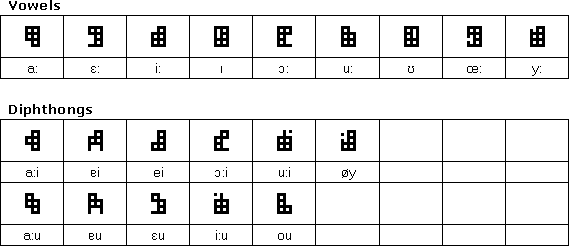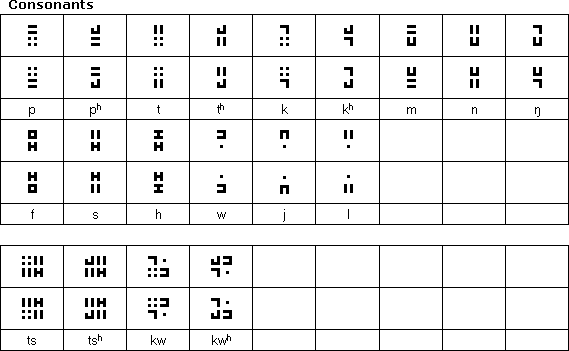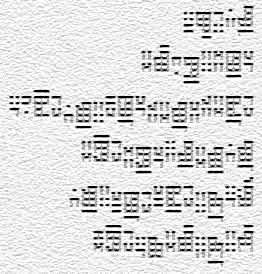Cantonese Grid Script is an alternative way of writing Cantonese invented by Desmond Lee (sumomo_nagamoto@yahoo.com).
The script is written from right to left in horizontal lines running from top to bottom.
Each block represents a syllable. The nucleus of a syllable is placed at the centre of the block. Onset is to the left of the nucleus and coda is on the right. Tone marker is either written above or below the nucleus according to pitch level of the tones.
There are no syllabic delimiters. Even syllables are written a bit lower than the odd syllables to serve this purpose.
Based on a simplified version of the IPA vowel graph. Vowel letters are derived by removing some of the grid lines on the resulting six-boxed grid. For example, the unrounded front open vowel /a/ is located at the bottom left corner on the IPA vowel graph and the six-boxed grid as well. The two adjacent grid lines attached to the bottom left corner point are removed from the six-boxed grid. The modified grid is the letter for vowel /a/. All unrounded vowel letters are formed by removing two adjacent grid lines. For rounded vowel letters, only one adjacent grid line is removed.
Similar to the vowels, but this time remove the adjacent lines of the two vowels in a diphthong. Whenever appropriate, dots can be used to indicate the first component of diphthongs, in order to avoid confusion. For example, without marking the first component with a dot, the letters for /iu/ and /ui/ would be identical.
Desmond started by breaking down phonemes into components such as bilabial, plosive, alveolar, etc. Then he assigned a symbolic letter to each component, reflecting some features of the component, for example, two horizontal lines for bilabial and a U-shaped letter for nasal. The two most significant components of each consonant are stacking to form the letter. The stacking order is not regularised so as to increase the degree of freedom in aesthetics. Two or more consonant letters can be combined to form new letters for consonant clusters.
Hong Kong Cantonese has six tones. The third tone is considered to be a neutral tone and is not marked. The first and second tones have higher pitch levels and the fourth, fifth and sixth tones have lower pitch levels. Markers for the former tones are placed above the nucleus letter in a syllabic block, while markers for the latter tones are placed below it.
Markers for level tones are horizontal lines, while markers for rising and falling tones are L-shaped lines.




Information about Cantonese | Phrases | Numbers | Family words | Time expressions | Tower of Babel | Cantonese courses on: Amazon.com and Amazon.co.uk [affilate links]
Constructed scripts for: Ainu | Arabic | Chinese languages | Dutch | English | Hawaiian | Hungarian | Japanese | Korean | Lingala | Malay & Indonesian | Persian | Tagalog / Filipino | Russian | Sanskrit | Spanish | Taino | Turkish | Vietnamese | Welsh | Other natural languages | Colour-based scripts | Tactile scripts | Phonetic/universal scripts | Constructed scripts for constructed languages | Adaptations of existing alphabets | Fictional alphabets | Magical alphabets | A-Z index | How to submit a constructed script
[top]
Why not share this page:

If you like this site and find it useful, you can support it by making a donation via PayPal or Patreon, or by contributing in other ways. Omniglot is how I make my living.
Note: all links on this site to Amazon.com, Amazon.co.uk
and Amazon.fr
are affiliate links. This means I earn a commission if you click on any of them and buy something. So by clicking on these links you can help to support this site.
Get a 30-day Free Trial of Amazon Prime (UK)
If you're looking for home or car insurance in the UK, why not try Policy Expert?
[top]